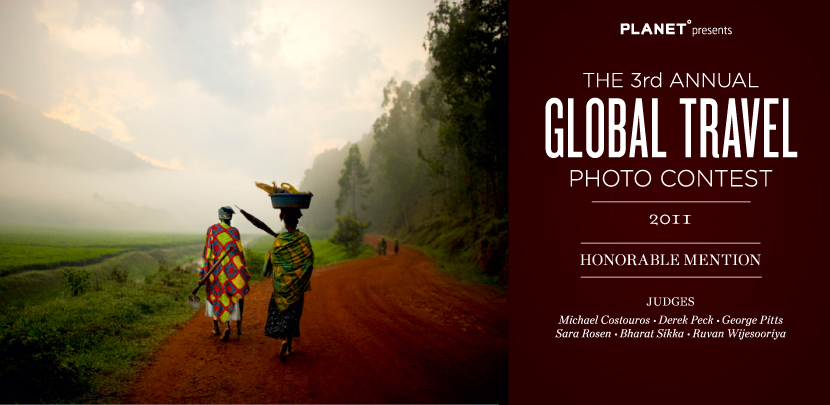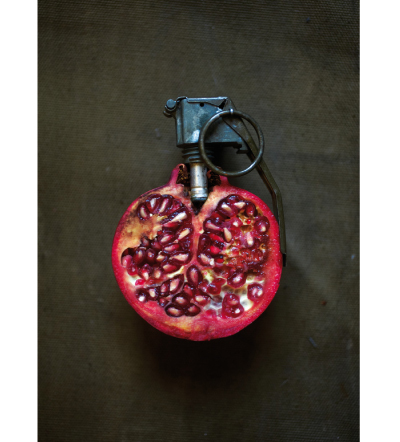
Fruit of the Boom (Granate), 2010
 Good Weather
Good Weather, an exhibit of Berlin-based artist Sarah Illenberger’s photographs at Gelstalten Space through September 11th, is an exercise in dissonance. A simple light bulb, upon a moment’s inspection, turns out to be a pear. A minimalist pair of headphones suddenly reveals itself to be made of two cupcake wrappers strung together. Straightforward in composition, lighting, and sly good nature, an Illenberger still life is lovingly handcrafted to wreak havoc on the viewer’s expectations every time. A halved pomegranate, with only a bit of metal stuck at the top, becomes an instantly recognizable hand grenade—but hasn’t the meat’s rich color, the glisten on the seeds, the plain
bloodiness of a pomegranate always spoken to your subconscious of violence? And if it didn’t, won’t it now? The joke in the photos isn’t that you’re seeing a trick object; it’s that you’re seeing two opposing images at once, and neither will yield. Illenberger spoke to PLANET about bringing her contradictions to a gallery space—right down to the name of the show.
(more…)
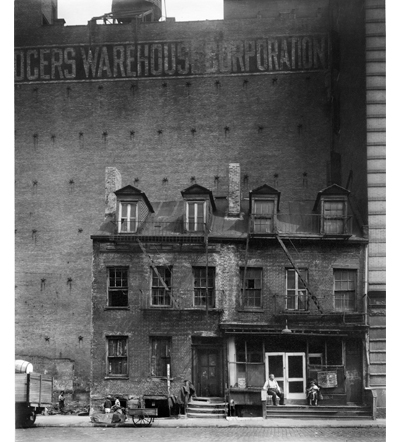

Peter Sekaer began touring the United States as a government photographer in 1936, documenting derelict cities and stricken farmland. His work, the focus of Signs of Life: Photographs by Peter Sekaer opening at the International Center of Photography on September 9th, revels less in the pointed dramatization practiced by so many of his contemporaries. Rather than produce a poised Migrant Mother, Sekaer drew his lens back and merged environment with sitter. His subjects’ everyday functionality in their new, extraordinary circumstances provided Sekaer’s narrative. The overall tableau is something very akin to what the unaffected human eye experiences.
Click for Slideshow

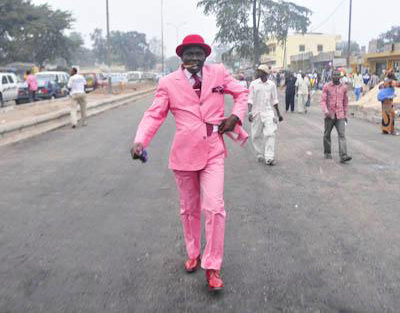
Courtesy Daniele Tamagni and Danziger Projects


In the troubled southern suburbs of Brazzaville, the Congo’s capital city, a resilient group of men have traded arms for Armani. The sapeurs, as captured in Daniele Tamagni & Africolor at Danziger Proejcts through September 10th, are Congolese men who abide by a strict moral code that’s signaled publicly by their equally rigorous dress rules. Tamagni, an Italian photographer working in several African regions, has produced photographs that reveal men in impeccably tailored, brilliantly colored three-piece suits, brandishing canes and cigars in the middle of slum neighborhoods. These men save up for months—often years—for an outfit.
Though the Sape movement first gained popularity as a way of resisting the 1970s national ban on western clothing, Tamagni no longer sees it as politically motivated. Today he sees it as both a form of “social affirmation,” and as an art in its own right. Not only is “dressing up a way to escape and forget poverty…but also their aesthetic is amazing, because they re-mix and re-interpret the Western brand outfits.” If fashion has truly become a life philosophy for the sapeurs, it’s clear that it’s a living, breathing dogma. “It’s a mix of dandyism with old colonial accessories and hip-hop style,” Tamagni explains. “It’s impossible to define their aesthetic.”
(more…)
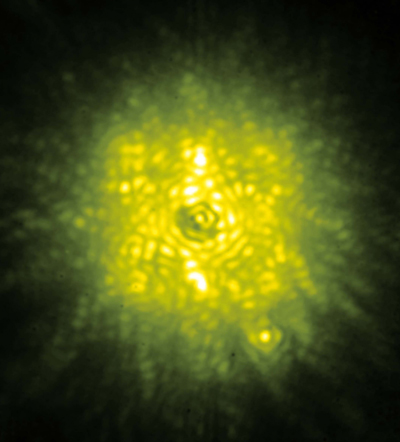
A Star Is Found © AMNH\ Ben Oppenheimer, Douglas Brenner

A paintbrush, an easel, a canvas, some paint. It used to be that works of art were created using a no frills set of materials like that, with maybe a color palette or a beret thrown in for good measure. While we’re far removed from the heyday of the French Impressionists, it’s likely that even the most forward-thinking of contemporary artists working with the most advanced tools of the trade wouldn’t know how to operate a telescopic coronagraph. But that’s exactly what was used by researchers in the American Museum of Natural History’s Department of Astrophysics to capture the spectacular image of an unknown star in the Big Dipper for an out-of-this-world work of art.
Titled “A Star Is Found,” and bearing resemblance to some menacing aquatic invertebrate or an experiment with green gelatin gone wrong, the image was never meant to hang on the walls of a gallery. Rather, it is an accidental masterpiece created in the pursuit of scientific research. A new star was discovered, and in the process, so was an unexpected thing of beauty – or something close to beauty, anyway. For the new exhibit “Picturing Science,” the museum’s curators have assembled a collection of spectacular prints that were produced with the same basic approach.
(more…)
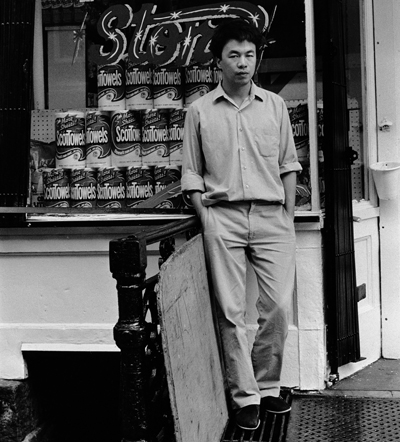
Ai Weiwei. Williamsburg, Brooklyn. 1983. Courtesy of Three Shadows Photography Art Centre and Chambers Fine Art.

Years before becoming the loudest voice of political dissent in the Chinese art landscape, 24-year-old Ai Weiwei arrived in a New York City seething with very different tensions from those of his hometown Beijing. His documentation of those years, now on display at the
Asia Society through August 14 in Ai Weiwei: New York Photographs 1983 – 1993, reveal a young artist investigating his interests in an unknown city.
The exhibition is divided roughly in two, with half the photographs showing members of Ai’s inner circle, and half portraying the city’s social wars from a resolutely street-level perspective. This portrait of New York is intimate. Photos of AIDS protests being broken up, ruined Bowery storefronts being taken over by stray dogs, and a diminutive Al Sharpton facing crowds at a Tawana Brawley demonstration all speak to Ai’s devotion to activism while remaining wholly present in the moment. A 1989 series depicting shaggy, joint-smoking protestors in Tompkins Square Park is equally effective as an image of modern American advocacy and as an implicit comparison with the bloody Tiananmen Square protests of the same year.
(more…)
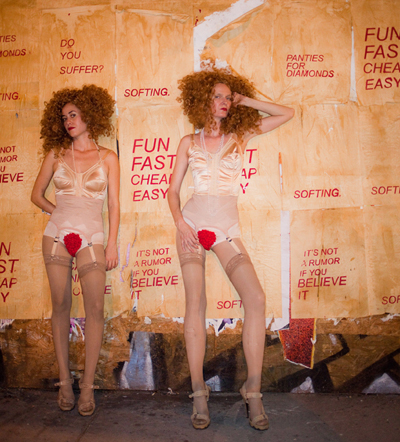
All images: Benjamin Heller
 Artist and Honey Space director Thomas Beale has been a friend of PLANET for several years. When he recently wrote to ask if I would consider covering an exhibit that was showing at his space, one that he felt was truly extraordinary, I was so struck by his compelling description of it that I suggested he write it himself. Conflict-of-interest concerns aside, I felt no one could write as intimately about how his gallery space had been transformed by this unique art piece and the various emotional dramas and resolutions that have unfolded there through it. – Derek Peck
Artist and Honey Space director Thomas Beale has been a friend of PLANET for several years. When he recently wrote to ask if I would consider covering an exhibit that was showing at his space, one that he felt was truly extraordinary, I was so struck by his compelling description of it that I suggested he write it himself. Conflict-of-interest concerns aside, I felt no one could write as intimately about how his gallery space had been transformed by this unique art piece and the various emotional dramas and resolutions that have unfolded there through it. – Derek Peck
I honestly didn’t know if it would work. I knew we could pull off the installation, and that the artists were prepared to step into their performance roles. Yet the question remained in my mind: would New Yorkers take 45 minutes out of their day to step into a private exhibition experience, with no more indication of what lay on the other side of a door than the vaguely suggestive title
Panties For Diamonds– A Psychodramatic Audition For Love In The Age Of Abandonment? And would enough people do this to keep the space active for five hours a day, five days a week?
(more…)
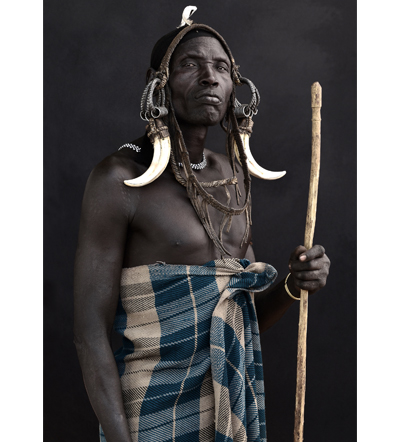
Bersidi, Mursi Man, March 2011

Austrian-born photographer Mario Marino has spent the last few months in the South Ethiopia’s Omo River Valley taking what he calls “photographic psychograms” of its inhabitants. Each gorgeously spare portrait represents a different micro-culture of the region, which Marino chose for its incredible density of distinct ethnic minorities.
“Faces of Africa” is a race against time of sorts. Marino searches the smallest, furthest villages for people whose heritage is under assault by the potent forces of tourism, technological advancement, and social globalization. His chosen method of preservation is to record a culture’s mark upon the body: white chalk used as face paint, intricate patterns shaved into hair, and throughout the portraits, ornaments made from the matchless leaves and shells of the South Ethiopian terrain. The sitters literally wear their homeland, supporting the claim of couturiers and choreographers everywhere that the body is simply one more medium for communication.
Click for slideshow
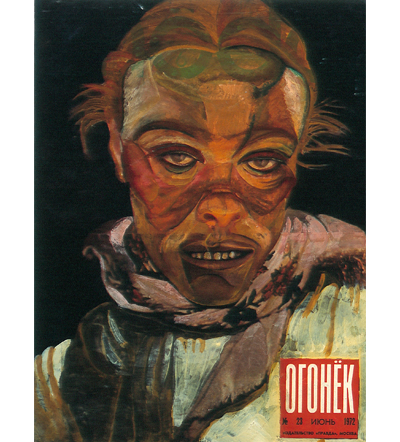
Sergey Zarva, Ogonyok, 2001. Courtesy the artist and Regina Gallery, Moscow/London

Fresh on the heels of civil unrest and hard-won liberation in places like Egypt, Libya, and the Ivory Coast, Ostalgia, a new show featuring more than 50 artists from 20 different countries across Eastern Europe and the former Soviet Republics is opening at the New Museum. The three-floor exhibit takes its name from the German ostalgie, a word that was on everyone’s tongue in the 1990s, nostalgic and morose for the golden era prior to the disintegration of the Communist Bloc. The show explores the full spectrum of emotional deviances that arose when the Soviet Union fell and Communism was permanently hobbled —a time before, during and after nations were forced to change their names, currency, constitutions and to a certain extent, their identities. Borders blurred, people felt the tumultuous aftershakes of their fallen ideologies and were forced to recommit themselves to a new history, a fresh place — despite the inexpressible trauma of losing one’s entire foundation.
(more…)
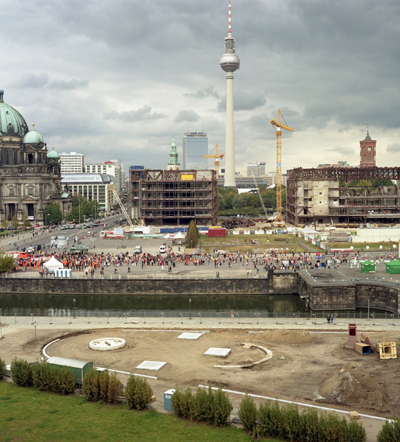
Click for slideshow Palast 2007

Just as New Yorkers are scrutinizing the development of the World Trade Center site, Berliners are scrutinizing the development of the Palast der Republik site. The Palast, an immense, East German government building completed in 1976, was condemned for asbestos in 1992 and demolished from 2006 to 2010. Located along the River Spree, amid stately nineteenth century buildings, at the very heart of Berlin’s cultural and tourist district, it had become, after the wall fell in 1989, a very visible symbol of all the wrong things: communism, oppression, censorship, and very, very bad style. A long, low concrete slab covered with gold mirrored glass, it looked like a flashy high security prison. Inside, it housed administration spaces for the city’s communist government and public spaces (lounges, bars, cafes, a bowling alley) where citizens could socialize in state-sanctioned splendor. The interiors were finished in the style of the time, with shag carpets, colored wallpaper, and chrome chandeliers studded with globe lights.
To replace the Palast the city chose to reconstruct the shell of the eighteenth century castle that previously occupied the site, which was damaged during World War II and demolished in 1950. This new castle will house a museum, a library, and shopping mall. It’s a brazen act of historical amnesia, one that looks past an unattractive chapter in history to one that’s more palatable. The project, which was suspended for financial reasons, is slated for completion in the next decade. Just last month a temporary structure, with exhibition space and a lookout point for tourists, opened at the site.
(more…)





 Facebook
Facebook Permalink
Permalink Digg
Digg Reddit
Reddit LinkedIn
LinkedIn StumbleUpon
StumbleUpon Tumblr
Tumblr






